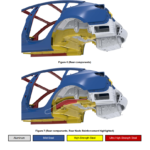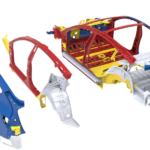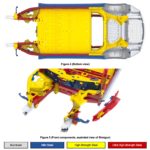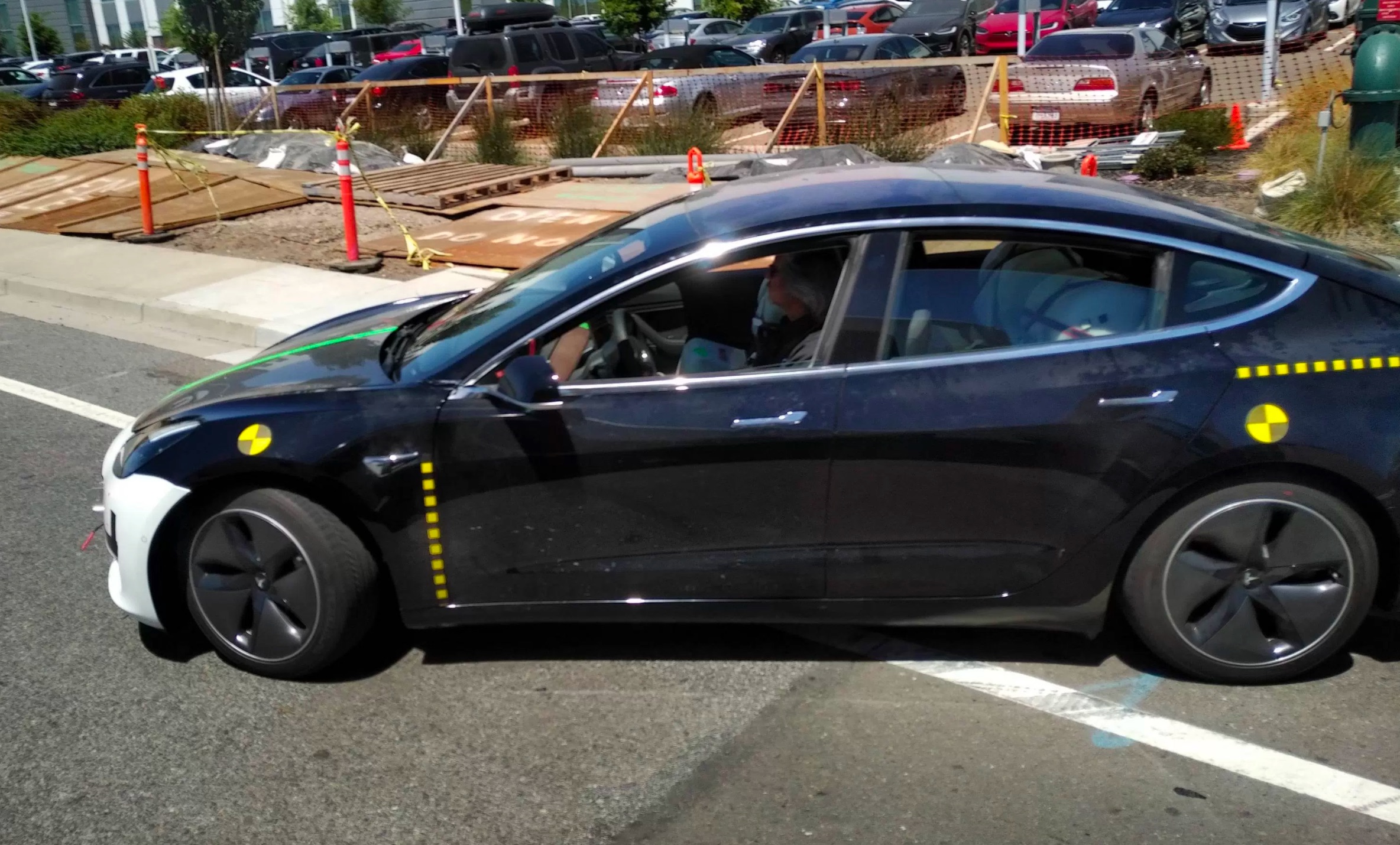
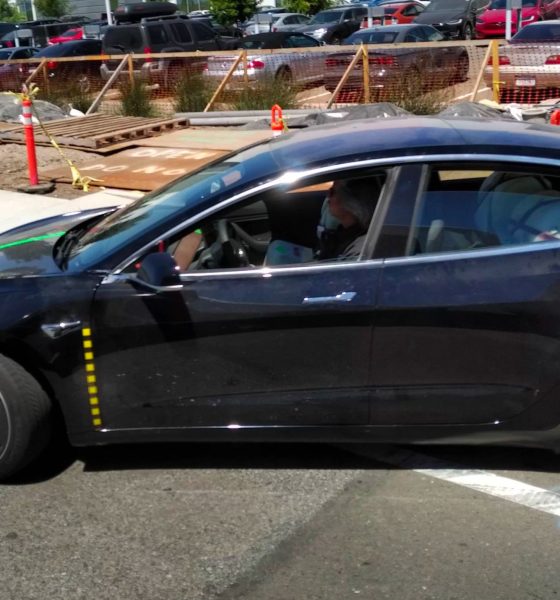
News
Tesla Model 3’s body structure is a strategic blend of aluminum and ultra high-strength steel
New photos from Tesla Model 3’s Body Repair Tech Note reveal a metal composition for the vehicle’s structure that strikes a perfect balance between world class safety and cost effectiveness.
One might recall Tesla CEO Elon Musk giving a tonque-in-cheek response about Model 3’s 5-star safety rating during a speech in Fremont, California. “The Volvo [S60] is arguably the second safest car in the world”, said Musk while alluding to the fact that Model 3 takes top honors for being the safest car in the world.
Photos posted to Twitter and shared on Reddit illustrate just how Tesla has been able to achieve a Model 3 body structure design that’s lightweight and has unparalleled strength at an entry level price point.
Looking at a front quarter exploded view of the Model 3 body, one can see the various compositions of steel the Tesla engineers used across the machine-stamped, multi-layer structure.
Tesla uses three different grades of steel, from mild steel used on the outer body structure where it’s designed to absorb initial impacts, and high-strength, to ultra high-strength used in the vehicle’s core. For instance, the A-pillar and B-pillar (noted in red on the graphic) is fabricated from ultra high-strength steel in order to provide maximum rollover protection. Model 3’s front frame rail is a composition between high-strength and ultra high-strength steel, and serves as the main support for the front “crumple zone”.
Tesla Model 3’s body repair manual notes that “Structural Pulling” is not allowed, meaning that any structural component that’s welded, weld-bonded, riveted, or rivet-bonded to the vehicle can not undergo a process wherein the straightening of structural parts are facilitated through a hydraulic pulling machine. Doing so would compromise the yield strength of the metals being used.
Also noted in the Model 3 structural diagram is the “underbelly” that serves as the main support for Model 3’s skateboard style battery pack, similar to what’s used in its older Model S and Model X siblings. The entire underside of the vehicle is fabricated from high-strength steel.
Side impact safety on the Model 3 is bolstered by a fully fortified closed steel structure in ultra high-strength steel. Looking at the crash test video showing a side-pole impact test performed on Tesla’s Model 3 and Volvo’s S60, one can easily see the level of deformity the Volvo has over the Model 3.
Watch a Tesla Model 3 vs. Volvo S60 side-pole impact test pic.twitter.com/dXBQkstrdo
— Tesla (@Tesla) July 29, 2017
Lastly, lightweight aluminum is introduced in areas of the body structure that are less susceptible to accidental impact such as the trunk floor and wheel wells. Using aluminum helps Model 3 maintain a relatively light curb weight of 3,549 lbs. for the standard version and 3,814 lbs. for the Long Range Model 3 with larger (and heavier) battery pack.
All in all, Tesla’s use of various steels and aluminum in Model 3’s body structure can be seen as a learning experience and first iteration towards even more affordable and higher volume production down the road – Model Y.

Elon Musk
Elon Musk and Tesla AI Director share insights after empty driver seat Robotaxi rides
The executives’ unoccupied tests hint at the rapid progress of Tesla’s unsupervised Robotaxi efforts.

Tesla CEO Elon Musk and AI Director Ashok Elluswamy celebrated Christmas Eve by sharing personal experiences with Robotaxi vehicles that had no safety monitor or occupant in the driver’s seat. Musk described the system’s “perfect driving” around Austin, while Elluswamy posted video from the back seat, calling it “an amazing experience.”
The executives’ unoccupied tests hint at the rapid progress of Tesla’s unsupervised Robotaxi efforts.
Elon and Ashok’s firsthand Robotaxi insights
Prior to Musk and the Tesla AI Director’s posts, sightings of unmanned Teslas navigating public roads were widely shared on social media. One such vehicle was spotted in Austin, Texas, which Elon Musk acknowleged by stating that “Testing is underway with no occupants in the car.”
Based on his Christmas Eve post, Musk seemed to have tested an unmanned Tesla himself. “A Tesla with no safety monitor in the car and me sitting in the passenger seat took me all around Austin on Sunday with perfect driving,” Musk wrote in his post.
Elluswamy responded with a 2-minute video showing himself in the rear of an unmanned Tesla. The video featured the vehicle’s empty front seats, as well as its smooth handling through real-world traffic. He captioned his video with the words, “It’s an amazing experience!”
Towards Unsupervised operations
During an xAI Hackathon earlier this month, Elon Musk mentioned that Tesla owed be removing Safety Monitors from its Robotaxis in Austin in just three weeks. “Unsupervised is pretty much solved at this point. So there will be Tesla Robotaxis operating in Austin with no one in them. Not even anyone in the passenger seat in about three weeks,” he said. Musk echoed similar estimates at the 2025 Annual Shareholder Meeting and the Q3 2025 earnings call.
Considering the insights that were posted Musk and Elluswamy, it does appear that Tesla is working hard towards operating its Robotaxis with no safety monitors. This is quite impressive considering that the service was launched just earlier this year.
Elon Musk
Starlink passes 9 million active customers just weeks after hitting 8 million
The milestone highlights the accelerating growth of Starlink, which has now been adding over 20,000 new users per day.

SpaceX’s Starlink satellite internet service has continued its rapid global expansion, surpassing 9 million active customers just weeks after crossing the 8 million mark.
The milestone highlights the accelerating growth of Starlink, which has now been adding over 20,000 new users per day.
9 million customers
In a post on X, SpaceX stated that Starlink now serves over 9 million active users across 155 countries, territories, and markets. The company reached 8 million customers in early November, meaning it added roughly 1 million subscribers in under seven weeks, or about 21,275 new users on average per day.
“Starlink is connecting more than 9M active customers with high-speed internet across 155 countries, territories, and many other markets,” Starlink wrote in a post on its official X account. SpaceX President Gwynne Shotwell also celebrated the milestone on X. “A huge thank you to all of our customers and congrats to the Starlink team for such an incredible product,” she wrote.
That growth rate reflects both rising demand for broadband in underserved regions and Starlink’s expanding satellite constellation, which now includes more than 9,000 low-Earth-orbit satellites designed to deliver high-speed, low-latency internet worldwide.
Starlink’s momentum
Starlink’s momentum has been building up. SpaceX reported 4.6 million Starlink customers in December 2024, followed by 7 million by August 2025, and 8 million customers in November. Independent data also suggests Starlink usage is rising sharply, with Cloudflare reporting that global web traffic from Starlink users more than doubled in 2025, as noted in an Insider report.
Starlink’s momentum is increasingly tied to SpaceX’s broader financial outlook. Elon Musk has said the satellite network is “by far” the company’s largest revenue driver, and reports suggest SpaceX may be positioning itself for an initial public offering as soon as next year, with valuations estimated as high as $1.5 trillion. Musk has also suggested in the past that Starlink could have its own IPO in the future.
News
NVIDIA Director of Robotics: Tesla FSD v14 is the first AI to pass the “Physical Turing Test”
After testing FSD v14, Fan stated that his experience with FSD felt magical at first, but it soon started to feel like a routine.

NVIDIA Director of Robotics Jim Fan has praised Tesla’s Full Self-Driving (Supervised) v14 as the first AI to pass what he described as a “Physical Turing Test.”
After testing FSD v14, Fan stated that his experience with FSD felt magical at first, but it soon started to feel like a routine. And just like smartphones today, removing it now would “actively hurt.”
Jim Fan’s hands-on FSD v14 impressions
Fan, a leading researcher in embodied AI who is currently solving Physical AI at NVIDIA and spearheading the company’s Project GR00T initiative, noted that he actually was late to the Tesla game. He was, however, one of the first to try out FSD v14.
“I was very late to own a Tesla but among the earliest to try out FSD v14. It’s perhaps the first time I experience an AI that passes the Physical Turing Test: after a long day at work, you press a button, lay back, and couldn’t tell if a neural net or a human drove you home,” Fan wrote in a post on X.
Fan added: “Despite knowing exactly how robot learning works, I still find it magical watching the steering wheel turn by itself. First it feels surreal, next it becomes routine. Then, like the smartphone, taking it away actively hurts. This is how humanity gets rewired and glued to god-like technologies.”
The Physical Turing Test
The original Turing Test was conceived by Alan Turing in 1950, and it was aimed at determining if a machine could exhibit behavior that is equivalent to or indistinguishable from a human. By focusing on text-based conversations, the original Turing Test set a high bar for natural language processing and machine learning.
This test has been passed by today’s large language models. However, the capability to converse in a humanlike manner is a completely different challenge from performing real-world problem-solving or physical interactions. Thus, Fan introduced the Physical Turing Test, which challenges AI systems to demonstrate intelligence through physical actions.
Based on Fan’s comments, Tesla has demonstrated these intelligent physical actions with FSD v14. Elon Musk agreed with the NVIDIA executive, stating in a post on X that with FSD v14, “you can sense the sentience maturing.” Musk also praised Tesla AI, calling it the best “real-world AI” today.

